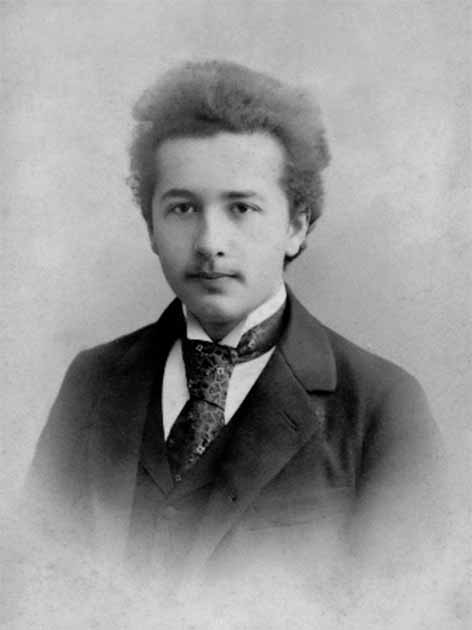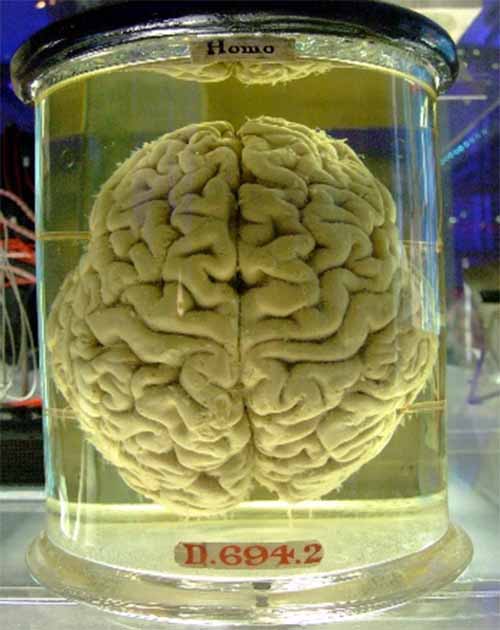
Searching for Genius: Einstein’s Stolen Brain
When you think of intelligent people, Albert Einstein may be the first name to come to mind. Known as one of history’s greatest geniuses, he fascinated the world with his many contributions to science during his lifetime. Given his high level of intellect, many wondered about the structure of his brain. Was it quite different from the brains of ordinary people? Was there something special about it that gave him the ability to learn and postulate as he did? To determine the truth, the man who performed Einstein’s autopsy, Thomas Harvey, stole his brain to perform scientific observations.
Harvey, going against Einstein’s wishes to be fully cremated, performed several tests on Einstein’s brain to determine just what was so different about the genius. What did Harvey discover, and what happened to Einstein’s brain in the end?

Einstein as a 16-year-old prodigy. (Public Domain)
The Development of Einstein’s Genius
Albert Einstein was born in 1879 in the Kingdom of Württemberg in the German Empire. After spending his childhood in Munich, his family moved to Italy in the mid-1890s. During his school years, Einstein excelled in subjects including math and physics, and was even recorded to have taught himself both algebra and Euclidean geometry in just a single summer at age 12. His tutor, Max Talmud, claimed that Einstein had completed an entire geometry textbook he had given him, and soon, “the flight of his mathematical genius was so high I could not follow.”
Beyond math and physics, Einstein also took a strong interest in philosophy. At the age of 13, he chose Kant as his favorite philosopher, even though his texts were normally quite difficult to comprehend for the average person.
He continued to focus on math and physics in his later schooling in Switzerland, excelling in his classes and surpassing all of his classmates in grades. Mileva Marić, Einstein’s first wife, was the only woman enrolled in his math and physics courses at his polytechnic school. This interested him greatly, and a romance budded between the two debating scientific topics and reading the same books.
In 1901, Einstein landed a job at the Swiss Patent Office in Bern. He would evaluate patent applications for various electrical devices, an experience that gave him greater insight into how electricity worked. These evaluations led him to consider how electricity is transmitted and the electrical-mechanical synchronization of time, which later influenced his theories about light, time, and space.
Soon after this, Einstein joined an academic discussion group with a few friends called the Olympia Academy and began publishing scientific papers. By 1908, he was appointed as a lecturer at the University of Bern, which later evolved into a full-time position as a professor in theoretical physics. This position later launched him into greater success throughout Europe, including positions in the Prussian Academy of Sciences, Kaiser Wilhelm Institute for Physics, German Physical Society, and Royal Netherlands Academy of Arts and Sciences.
In 1922, Einstein received the Nobel Prize in Physics for his discovery of the photoelectric effect, which is a phenomenon in which electrically charged particles are released from a material when it absorbs electromagnetic radiation. By the 1930s, he had also developed his general theory of relativity and proved the gyromagnetic effect, which states that a change in the magnetic field of a free body will cause the body to rotate.
- The Ancient History of UFOs and the Oppenheimer-Einstein Report
- Smarter Brains Are Blood-Thirsty Brains
The Brain Thief
Albert Einstein died on April 18th, 1955, after a blood vessel burst near his heart. An intelligent man, Einstein had strict wishes for his body after his death. He had specific instructions left behind that instructed for his body to be cremated and scattered. He even asked that the scattering of his ashes remain a secret, so that those who idolized him wouldn’t know where his remains were located. He ultimately did not want to be studied, and did not want extra attention brought to his death.
Unfortunately, Einstein’s wishes were not fully followed. The pathologist handling his body, Thomas Harvey, went against Einstein’s wishes and removed his brain for later study. After a few days of keeping the brain, he admitted to Einstein’s family that he had stolen the brain and asked for permission to keep it. Though reluctant, Einstein’s son, Hans, gave his initial permission for Harvey to keep the brain. Though he received this permission after doing the act, Harvey still lost his job at the Princeton hospital, and he decided to take the brain with him out of state.
Upon leaving his prior home, he landed in Philadelphia, along with the brain. It was here that he decided to cut Einstein’s brain into 240 pieces and kept the pieces housed in two jars of celloidin to preserve them. Celloidin, a harder and more rubbery form of cellulose, is frequently used to mount biological samples that are particularly hard, brittle, or can crumble easily. He stored the jars in his basement for future work.
However, Harvey’s wife wasn’t a fan of his new little collection. She threatened to throw the jars away, which prompted him to take the jars with him on a trip to the Midwest. In Kansas, he took a job as a medical supervisor in a biology lab, where he first began studying the brain. He kept the brain jars in a small cider box which he hid under a beer cooler. He began sending some of the chunks to other researchers around the world that were interested in getting a piece of Einstein’s famous brain.
After moving to Missouri, he continued to study the brain while he practiced medicine. Years later, in 1988, he failed a competency exam which resulted in him losing his medical license. This loss prompted him to move back to Kansas, where he began working on an assembly line. He would spend his evenings drinking with his neighbors (one of which was poet William Burroughs) and telling them about the brain and his recent work with it.
Before his death in 2007, Harvey donated the remains of Einstein’s brain to the National Museum of Health and Medicine and the Mütter Museum in Philadelphia, which both have parts of his brain on display.

Human Brain in a Vat (Gaetan Lee / CC BY 2.0)
The Differences in Einstein’s Brain
The first study on Einstein’s brain was published in 1985. General information was presented about it, including the size and weight before it was cut. Harvey and other scientists then claimed that Einstein’s brain had an abnormal ratio of neurons to glia, types of brain cells. It was the first of six different studies that claimed that Einstein’s brain had different proportions of cells or tissue compared to the average. A later study claimed that while Einstein did not have more neurons than others, his tissue was thinner, which could have increased the speed of communication between cells. However, harsh criticism has been made about these studies.
In particular, psychologist Terence Hines claims that the values in the studies were greatly exaggerated or improperly described. According to the data in the original 1985 study, the neuron-to-glia ratio was significantly smaller in parts of Einstein’s brain compared to other brains. It is also important to note that on average, only 10 control brains were used in each study, and they ranged in age from 47-80, though Einstein was 76 when he died. The age of the brains could significantly alter the results of these studies and could make these results inaccurate.
In addition to this, the control brains used were all freshly sourced. Since Einstein’s harvested brain was several decades old at this point (and had spent many years in questionable housing including jars and boxes), the structure of his brain remains could have been altered over time.
Many of these studies required the counting of cells, which is often disregarded as an inaccurate assessment method. Because counting is often subjective (and cells are quite small and difficult to distinguish at times), it cannot be certain that an error was not made in this analysis. Plus, Harvey and his partners refused to discuss how Einstein’s brain was similar to the control brains, which could be perceived as dishonest.
Finally, many of the tests done on Einstein’s brain have only been done on small portions. Since the brain was cut into 240 pieces, experiments have not been able to be performed on the brain as a whole. This could significantly impact results when it comes to comparing his brain to others.
Only one study was done on the brain as a whole based on a photo taken of the brain before it was cut. Some scientists claimed the brain had an abnormal folding pattern in the part of the brain responsible for mathematic ability, but scientists were not blinded to the photographs, which could have introduced bias to the analysis.
- Why do humans have such large brains? (And why aren’t they larger?)
- Scientists Create Fully Functioning Neanderthal Mini Brain

Einstein stated his desire for his ashes to be scattered (Public Domain)
Respecting Einstein’s Wishes
Ultimately, Einstein made the choice to be fully cremated for a reason. He knew that those around him would want to prod at his body and try to determine what made him tick. In his requests, he clearly wanted to avoid this, likely because he figured what we already knew - his brain wasn’t going to be that special. While Einstein himself was a special man, his brain alone did not make him. It did not have a special superpower, nor was it made of anything particularly different than everyone else’s brain. He just happened to be gifted with the ability to do more with it than the average person.
Even now, his brain has not yet been put to rest. Though it is on display in reputable museums, it was never cremated and scattered according to Einstein’s wishes. Though it is fascinating to look at his brain, it is unsettling to reflect on the blatant disregard for Einstein’s wishes for his own body post-mortem.
Now that the only descendants of Einstein that are still alive are his great-grandchildren, it is unclear what will happen to the brain in the future. Will his brain continue to be left on display for fascinated onlookers, or will it eventually be returned to the family in an act of respect? Only time will tell.
Top image: Conceptual image of a large stone in the shape of a human brain. Source: Orlando Florin Rosu / Adobe Stock
By Lex Leigh
References
Albert Einstein Biographical. NobelPrize.org. (n.d.). Retrieved August 1, 2022, from https://www.nobelprize.org/prizes/physics/1921/einstein/biographical/
Balter, M. (2009, April 17). Closer Look at Einstein’s Brain. Science. Retrieved August 2, 2022, from https://www.science.org/content/article/closer-look-einsteins-brain
Encyclopedia Britannica, inc. (n.d.). Albert Einstein. Encyclopedia Britannica. Retrieved August 1, 2022, from https://www.britannica.com/biography/Albert-Einstein
Hughes, V. (2014, April 21). The Tragic Story of how Einstein's Brain Was Stolen and Wasn't Even Special. Science. Retrieved August 1, 2022, from https://www.nationalgeographic.com/science/article/the-tragic-story-of-how-einsteins-brain-was-stolen-and-wasnt-even-special?loggedin=true
Margaritoff, M. (2021, August 11). Inside the Bizarre Story of Albert Einstein's Brain - After It Was Stolen from His Body. All That's Interesting. Retrieved August 1, 2022, from https://allthatsinteresting.com/albert-einstein-brain
Murray, S. (2019, April 9). Who Stole Einstein's Brain? HCPLive. Retrieved August 1, 2022, from https://www.hcplive.com/view/who-stole-einsteins-brain
Tapalaga, A. (2022, January 31). How Albert Einstein's Brain Was Stolen and Cut in 240 Pieces. Medium. Retrieved August 3, 2022, from https://historyofyesterday.com/how-albert-einsteins-brain-was-stolen-and-cut-in-240-pieces-d4fae1bce82c
















Comments
I find much of this article very hard to accept as being true.